|
|
|||
|
HOME
|
US Navy -
ships
|
US Navy - air
units
|
USMC - air
units
|
International
Navies
|
Weapon Systems
|
Special Reports |
|||
|
US Navy Zumwalt class Guided Missile Destroyer - DDG |
|||
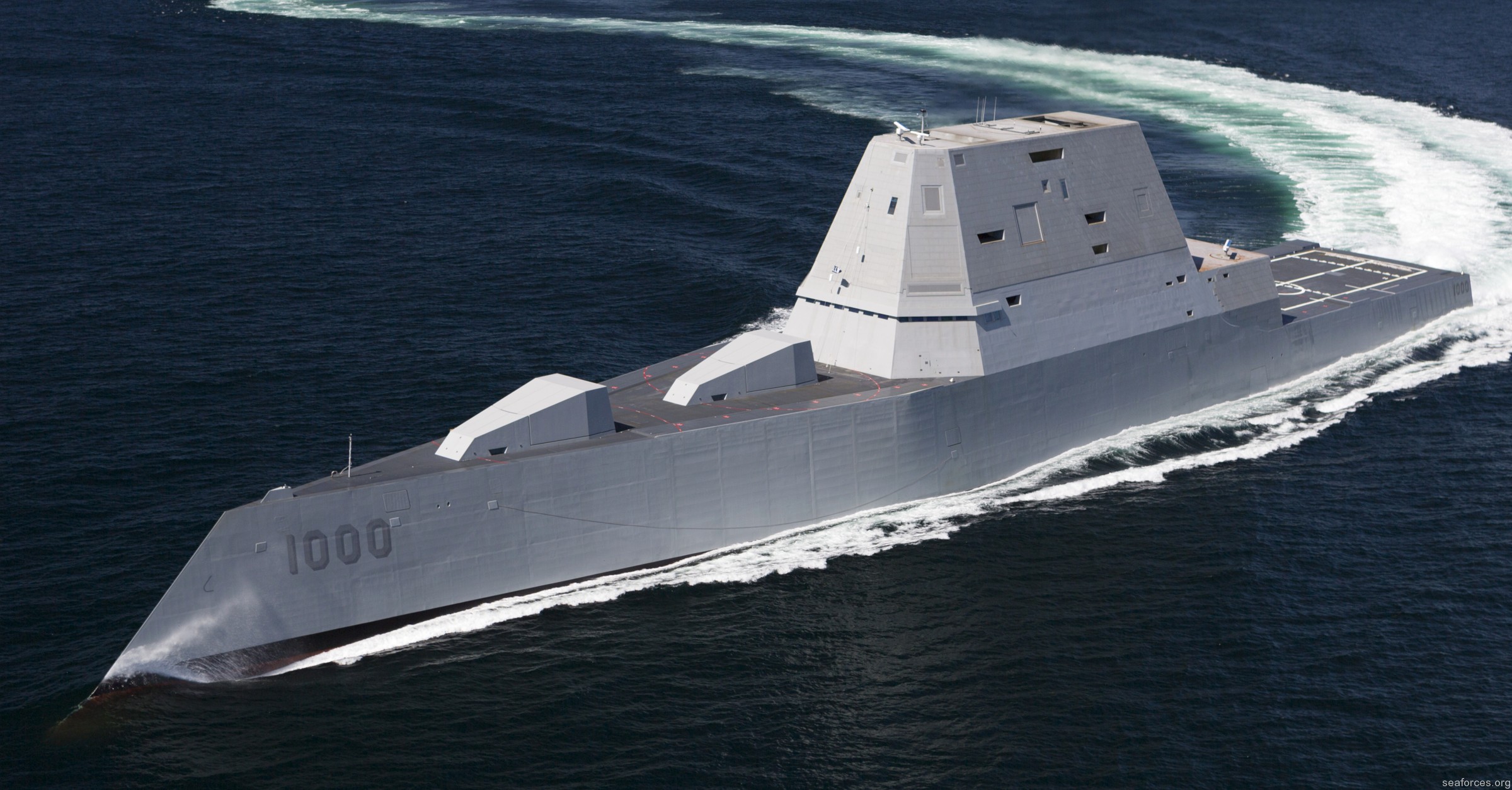
|
|||
| 07/22 | |||
| Ships: | |||
|
DDG 1000 USS Zumwalt (2016) DDG 1001 USS Michael Monsoor (2019) DDG 1002 USS Lyndon B. Johnson (2024 ?) |
|||
| Specifications: | |||
|
|||
|
The Zumwalt-class destroyer is a class of United States Navy guided
missile destroyers designed as multi-mission stealth ships with a
focus on land attack. It is a multi-role class that was designed for
secondary roles of surface warfare and anti-aircraft warfare and
originally designed with a primary role of naval gunfire support. It
was intended to take the place of battleships in meeting a
congressional mandate for naval fire support. The ship is designed
around its two Advanced Gun Systems, their turrets and magazines,
and unique Long Range Land Attack Projectile (LRLAP) ammunition.
LRLAP procurement was cancelled, rendering the guns unusable, so the
Navy is re-purposing the ships for surface warfare. The class design
emerged from the DD-21 "land attack destroyer" program as "DD(X)". The vessels' distinctive appearance results from the design requirement for a low radar cross-section (RCS). The Zumwalt-class has a wave-piercing tumblehome hull form whose sides slope inward above the waterline, which dramatically reduces RCS by returning much less energy than a conventional flare hull form. The appearance has been compared to that of the historic USS Monitor, although it is actually more similar to CSS Virginia, Monitor's famous antagonist. The class has an integrated power system that can send electricity from its turbo-generators to the electric drive motors or weapons, the Total Ship Computing Environment Infrastructure (TSCEI), automated fire-fighting systems, and automated piping rupture isolation. The class is designed to require a smaller crew and be less expensive to operate than comparable warships. The lead ship is named Zumwalt for Admiral Elmo Zumwalt, and carries the hull number DDG-1000. Originally 32 ships were planned, with $9.6 billion research and development costs spread across the class. As costs overran estimates, the quantity was reduced to 24, then to 7, and finally to 3, significantly increasing the cost-per-ship to $4.24 billion (excluding R&D costs) and well-exceeding the per-unit cost of a nuclear-powered Virginia-class submarine ($2.688 billion). The dramatic per-unit cost increases eventually triggered a Nunn-McCurdy Amendment breach and cancellation of further production. In April 2016, the total program cost was $22.5 billion with an average cost of $7.5 billion per ship. Background and funding: Many of the features were developed under the DD-21 program ("21st Century Destroyer"), which was originally designed around the Vertical Gun for Advanced Ships (VGAS). In 2001, Congress cut the DD-21 program by half as part of the SC21 program; to save it, the acquisition program was renamed as DD(X) and heavily reworked. Originally, the Navy had hoped to build 32 destroyers. That number was reduced to 24, then to 7, due to the high cost of new and experimental technologies. On 23 November 2005, the Defense Acquisition Board approved a plan for simultaneous construction of the first two ships at Northrop Grumman's Ingalls yard in Pascagoula, Mississippi and General Dynamics' Bath Iron Works in Bath, Maine. However, at that date, funding had yet to be authorized by Congress. In late December 2005, the House and Senate agreed to continue funding the program. The U.S. House of Representatives allotted the Navy only enough money to begin construction on one destroyer, as a "technology demonstrator". The initial funding allocation was included in the National Defense Authorization Act of 2007. However, this was increased to two ships by the 2007 appropriations bill approved in September 2006, which allotted US$2.568 billion to the DDG-1000 program. On 31 July 2008, U.S. Navy acquisition officials told Congress that the service needed to purchase more Arleigh Burke-class destroyers, and no longer needed the next-generation DDG-1000 class, Only the two approved destroyers would be built. The Navy said the world threat picture had changed in such a way that it now makes more sense to build at least eight more Burkes, rather than DDG-1000s. The Navy concluded from fifteen classified intelligence reports that the DDG-1000s would be vulnerable to forms of missile attacks. Many Congressional subcommittee members questioned that the Navy completed such a sweeping re-evaluation of the world threat picture in just a few weeks, after spending some 13 years and $10 billion on the development of the surface ship program known as DD-21, then DD(X), and finally DDG-1000. Subsequently, Chief of Naval Operations Gary Roughead cited the need to provide area air defense and specific new threats such as ballistic missiles and the possession of anti-ship missiles by groups such as Hezbollah. The mooted structural problems have not been discussed in public. Navy Secretary Donald Winter said on 4 September that "Making certain that we have - I'll just say, a destroyer - in the '09 budget is more important than whether that’s a DDG 1000 or a DDG 51". On 19 August 2008, Secretary Winter was reported as saying that a third Zumwalt would be built at Bath Iron Works, citing concerns about maintaining shipbuilding capacity. House Defense Appropriations Subcommittee Chairman John Murtha said on 23 September 2008 that he had agreed to partial funding of the third DDG-1000 in the 2009 Defense authorization bill. A 26 January 2009 memo from John Young, the US Department of Defense's (DoD) top acquisition official, stated that the per ship price for the Zumwalt-class destroyers had reached $5.964 billion, 81 percent over the Navy's original estimate used in proposing the program, resulting in a breach of the Nunn-McCurdy Amendment, requiring the Navy to re-certify and re-justify the program to Congress or to cancel its production. On 6 April 2009, Defense Secretary Robert Gates announced that DoD's proposed 2010 budget will end the DDG-1000 program at a maximum of three ships. Also in April, the Pentagon awarded a fixed-price contract with General Dynamics to build the three destroyers, replacing a cost-plus-fee contract that had been awarded to Northrop Grumman. At that time, the first DDG-1000 destroyer was expected to cost $3.5 billion, the second approximately $2.5 billion, and the third even less. What had once been seen as the backbone of the Navy's future surface fleet with a planned production run of 32, has since been replaced by destroyer production reverting to the Arleigh Burke-class after ordering three Zumwalts. In April 2016, the U.S. Naval Institute stated the total cost of the three Zumwalt ships is about $22.5 billion with research and development costs, which is an average of $7.5 billion per ship. Construction: In late 2005, the program entered the detailed design and integration phase, for which Raytheon was the Mission Systems Integrator. Both Northrop Grumman Ship Systems and General Dynamics Bath Iron Works shared dual-lead for the hull, mechanical, and electrical detailed design. BAE Systems Inc. had the advanced gun system and the Mk-57 VLS. Almost every major defense contractor (including Lockheed Martin, Northrop Grumman Sperry Marine, L-3 Communications) and subcontractors from nearly every state in the U.S. were involved to some extent in this project, which was the largest single line item in the Navy's budget. During the previous contract, development and testing of 11 Engineering Development Models (EDMs) took place: Advanced Gun System, Autonomic Fire Suppression System, Dual Band Radar (X-band and L-band), Infrared, Integrated Deckhouse & Apertures, Integrated Power System, Integrated Undersea Warfare, Peripheral Vertical Launch System, Total Ship Computing Environment Infrastructure (TSCEI), Tumblehome Hull Form. The decision in September 2006 to fund two ships meant that one could be built by the Bath Iron Works in Maine and one by Northrop Grumman's Ingalls Shipbuilding in Mississippi. Northrop Grumman was awarded a $90M contract modification for materials and production planning on 13 November 2007. On 14 February 2008, Bath Iron Works was awarded a contract for the construction of Zumwalt (DDG-1000), and Northrop Grumman Shipbuilding was awarded a contract for the construction of Michael Monsoor (DDG-1001), at a cost of $1.4 billion each. On 11 February 2009, full-rate production officially began on the first Zumwalt-class destroyer. Construction on the second ship of the class, Michael Monsoor, began in March 2010. The keel for the first Zumwalt-class destroyer was laid on 17 November 2011. This first vessel was launched from the shipyard at Bath, Maine on 29 October 2013. The construction timetable in July 2008 was: - October 2008: DDG-1000 starts construction at Bath Iron Works - September 2009: DDG-1001 starts construction at Bath Iron Works - April 2012: DDG-1002 starts construction at Bath Iron Works - April 2013: DDG-1000 initial delivery - May 2014: DDG-1001 delivery - March 2015: Initial operating capability - Fiscal 2018: DDG-1002 delivery The Navy planned for Zumwalt to reach initial operating capability (IOC) in 2016. The second ship, Michael Monsoor, is to reach IOC in 2018, and the third ship, Lyndon B. Johnson (DDG-1002), is to reach IOC in 2021. Design: Stealth: Despite being 40% larger than an Arleigh Burke-class destroyer, the radar cross-section is more akin to that of a fishing boat, according to a spokesman for Naval Sea Systems Command. The tumblehome hull and composite deckhouse reduce radar return. Overall, the destroyer's angular build makes it "50 times harder to spot on radar than an ordinary destroyer." The acoustic signature is comparable to that of the Los Angeles-class submarines. Water sleeting along the sides, along with passive cool air induction in the mack reduces infrared signature. The composite deckhouse encloses much of the sensors and electronics. In 2008, Defense News reported there had been problems sealing the composite construction panels of this area; Northrop Grumman denied this. The U.S. Navy solicited bids for a lower cost steel deckhouse as an option for DDG-1002, the last Zumwalt destroyer, in January 2013. On 2 August 2013, the US Navy announced it was awarding a $212 million contract to General Dynamics Bath Iron Works to build a steel deckhouse for destroyer Lyndon B. Johnson (DDG-1002). The U.S. Naval Institute stated "the original design of the ship would have had a much smaller RCS, but cost considerations prompted the Navy over the last several years to make the trades in increasing RCS to save money..." To improve detection in non-combat situations by other vessels, such as traversing busy shipping channels or operating in inclement weather, the Navy is testing adding onboard reflectors to improve the design's radar visibility. The usefulness of the stealth features has been questioned. The class's role was to provide NSFS, which requires the ship to be in typically crowded near-shore waters, where such large and distinctive ships can be tracked visually. Tumblehome wave piercing hull: The Zumwalt-class destroyer reintroduces the tumblehome hull form, a hull form not seen to this extent since the Russo-Japanese War in 1905. It was originally put forth in modern steel battleship designs by the French shipyard Forges et Chantiers de la Méditerranée in La Seyne, Toulon. French naval architects believed that tumblehome, in which the beam of the vessel narrowed from the waterline to the upper deck, would create better freeboard, greater seaworthiness, and, as Russian battleships were to find, would be ideal for navigating through narrow constraints (e.g. canals). On the downside, the tumblehome battleships leaked and could be unstable, especially when turning at high speed. The tumblehome has been reintroduced in the 21st century to reduce the radar return of the hull. The inverted bow is designed to cut through waves rather than ride over them. The stability of this hull form in high sea states has caused debate among naval architects, with some charging that "with the waves coming at you from behind, when a ship pitches down, it can lose transverse stability as the stern comes out of the water - and basically roll over." Advanced Gun System: The Advanced Gun System is a 155 mm naval gun, two of which are installed in each ship. This system consists of an advanced 155 mm gun and its Long Range Land Attack Projectile (LRLAP). This projectile is a rocket with a warhead fired from the AGS gun; the warhead has a 11 kg / 24 lb bursting charge and has a circular error of probability of 50 meters. This weapon system has a range of 83 nautical miles (154 km); the fully automated storage system has room for up to 750 rounds. The barrel is water-cooled to prevent overheating and allows a rate of fire of 10 rounds per minute per gun. Using a Multiple Rounds Simultaneous Impact (MRSI) firing tactic the combined firepower from a pair of turrets gives each Zumwalt-class destroyer initial strike firepower equivalent to 12 conventional M198 field guns. To provide sufficient stability to fire these guns, the Zumwalts use ballast tanks to lower themselves into the water. In November 2016, the Navy moved to cancel procurement of the LRLAP, citing per-shell cost increases to $800,000–$1 million resulting from trimming of total ship numbers of the class. The Navy is monitoring research on alternative munitions, but since the AGS was tailor-made to use the LRLAP, modifications will be needed to accept different shells, which is unlikely to happen by the time the first Zumwalt vessel enters operational service in 2018, leaving it unable to fulfill the naval gunfire support role it was designed for. Lyndon B. Johnson, the last Zumwalt, is being considered for the installation of a railgun in place of one of the 155 mm naval guns after the ship is built. This is feasible because the installed Rolls-Royce turbine generators are capable of producing 78 megawatts (105,000 hp), enough for the electrically-powered weapon. Peripheral Vertical Launch System: The Peripheral Vertical Launch System (PVLS) is an attempt to avoid intrusion into the prized center space of the hull while reducing the risk of loss of the entire missile battery or of the ship in a magazine explosion. The system consists of pods of VLS cells distributed around the outer shell of the ship, with a thin steel outer shell and a thick inner shell. The design of the PVLS directs the force of any explosion outward rather than into the ship. Additionally, this design reduces the loss of missile capacity to the affected pod only. Aircraft and boat features: Two spots are available on a large aviation deck with a hangar capable of housing two full size SH-60 helicopters. Boats are handled within a stern mounted boat hangar with ramp. The boat hangar's stern location meets high sea state requirements for boat operations. Radar: Originally, the AN/SPY-3 active electronically scanned array primarily X band radar was to be married with Lockheed Martin's AN/SPY-4 S band volume search radar. Raytheon's X-band, active-array SPY-3 Multi-Function Radar (MFR) offers superior medium to high altitude performance over other radar bands, and its pencil beams give it an excellent ability to focus in on targets. SPY-3 will be the primary radar used for missile engagements. A 2005 report by Congress' investigative arm, the Government Accountability Office (GAO), questioned that the technology leap for the Dual Band Radar would be too much. On 2 June 2010, Pentagon acquisition chief Ashton Carter announced that they will be removing the SPY-4 S-band Volume Search Radar from the DDG-1000's dual-band radar to reduce costs as part of the Nunn-McCurdy certification process. Due to the SPY-4 removal, the SPY-3 radar is to have software modifications so as to perform a volume search functionality. Shipboard operators will be able to optimize the SPY-3 for either horizon search or volume search. While optimized for volume search, the horizon search capability is limited. The DDG-1000 is still expected to perform local area air defense. This system is thought to provide high detection and excellent anti-jamming capabilities, particularly when used in conjunction with the Cooperative Engagement Capability (CEC). It is, however, not reported if the CEC system will be installed on the Zumwalt-class destroyers upon commissioning, but it is scheduled for eventual incorporation in the ship type. In that the Zumwalt class has no AN/SPG-62 fire-control radars that are used for terminal guidance for Standard and Evolved Sea-Sparrow Missiles (ESSMs) anti-aircraft engagements, the SPY-3 will generate Interrupted Continuous Wave Illumination (ICWI) rather than the Continuous Wave Illumination of the AN/SPG-62 fire-control radars. Significant software modifications are required to support the ICWI, transmit and receive link messages to the missiles. Standard Missile (SM)-2 IIIA and the ESSM slated for Zumwalt class require modified missile receivers, transmitters, encoders, decoders and a redesigned digital signal processor to work with the ship's system. These modified missiles will not be able to be used on Aegis class ships. The SPY 3 had to be reprogrammed to do the volume search that the SPY-4 was supposed to have performed. With the duties of volume and surface search and terminal illumination there is concern that a large scale missile attack could overwhelm a radar’s resource management capacity. In such a case the radar may be unable to properly manage incoming threats or guide offensive missiles. The Dual Band Radar in its entirety (SPY-3 & SPY-4) is to be installed only on the Gerald R. Ford-class aircraft carrier Gerald R. Ford. With the development of the AMDR (Air and Missile Defense Radar), it seems unlikely the DBR is to be installed on any other platforms, as it is on the DDG-1000 class, or in total, as it is on Gerald R. Ford. The Enterprise Air Surveillance Radar (EASR) is a new design surveillance radar that is to be installed in the second Gerald R. Ford-class aircraft carrier, John F. Kennedy, in lieu of the Dual Band radar. The America-class amphibious assault ships starting with LHA-8 and the planned LX(R)-class amphibious warfare ships will also have this radar. AMDR (Air and Missile Defense Radar) was originally proposed to be installed in the hull of DDG-1000 type under the CG(X) program. However, due to cost growth, the CG(X) program was canceled. The AMDR has continued in fully funded development for installation on the DDG-51 Flight III ships. However, a smaller than optimally planned aperture of 14 feet (4.3 m), the AMDR for the Flight III ships is to be less sensitive than the 22 feet (6.7 m) variant that had been planned for CG(X). A study to place the AMDR on a DDG-1000 hull was done with the 22-foot (6.7 m) aperture primarily for Ballistic Missile Defense (BMD) purposes. In that the DDG-1000 does not have an Aegis combat system, as does the DDG-51 class ships, but rather the Total Ship Computing Environment Infrastructure (TSCEI), the Radar/Hull Study stated: ... that developing a BMD capability "from scratch" for TSCE was not considered viable enough by the study team to warrant further analysis, particularly because of the investment already made in the Aegis program. The navy concluded that developing IAMD software and hardware specifically for TSCE would be more expensive and present higher risk. Ultimately, the navy determined that Aegis was its preferred combat system option. Navy officials stated that Aegis had proven some BMD capability and was widely used across the fleet, and that the navy wanted to leverage the investments it had made over the years in this combat system, especially in its current development of a version that provides a new, limited IAMD capability. Common Display System: The ship's Common Display System is nicknamed "keds": Sailors operate keds via trackballs and specialized button panels, with the option to the interface by using touchscreens. The technology array allows sailors to monitor multiple weapons systems or sensors, saving manpower, and allowing it to be steered from the ops center. Sonar: A dual-band sonar controlled by a highly automated computer system will be used to detect mines and submarines. It is claimed that it is superior to the Burke's sonar in littoral ASW, but less effective in blue water/deep sea areas. - Hull-mounted mid-frequency sonar (AN/SQS-60) - Hull-mounted high-frequency sonar (AN/SQS-61) - Multi-function towed array sonar and handling system (AN/SQR-20) Although Zumwalt ships have an integrated suite of undersea sensors and a multi-function towed array, they are not equipped with onboard torpedo tubes, so they rely on their helicopters or ASROC missiles to destroy submarines that the sonar picks up. Propulsion and power system: The DDX proposed to use a permanent-magnet motor (PMM) within the hull. An alternate twin pod arrangement was rejected as the ramifications of pod drives would require too much development and validation cost to the vessel. The PMM is considered to be another technology leap and is the cause of some concern (along with the radar system) from Congress. As part of the design phase, Northrop Grumman had the world's largest permanent magnet motor, designed and fabricated by DRS Technologies. This proposal was dropped when the PMM motor failed to demonstrate that it was ready to be installed in time. Zumwalt will have Converteam's Advanced Induction Motors (AIM), rather than DRS Technologies' Permanent Magnet-Synchronous Motors (PMM). The exact choice of engine systems remains somewhat controversial at this point. The concept was originally for an integrated power system (IPS) based on in-hull permanent magnet synchronous motors (PMMs), with Advanced Induction Motors (AIM) as a possible backup solution. The design was shifted to the AIM system in February 2005 in order to meet scheduled milestones; PMM technical issues were subsequently fixed, but the program has moved on. The downside is that AIM technology has a heavier motor, requires more space, requires a "separate controller" to be developed to meet noise requirements, and produces one-third the amount of voltage. On the other hand, these very differences will force time and cost penalties from design and construction changes if the program wishes to "design AIM out" … The Integrated Power System (IPS) is, in some ways, similar to the old turbo-electric drive, the addition of PMMs and integration of all electrical power systems gives ten times the power available on current destroyers. It also reduces the ship's thermal and sound signature. The IPS has added to weight growth in the Zumwalt-class destroyer as noted by the GAO. The second ship of the class, Michael Monsoor, will require a new engine after she experienced problems during sea trials resulting in damaged turbine blades. Automation and fire protection: Automation reduces crew size on these ships: the Zumwalt-class destroyer's minimum complement is 130, less than half of needed by "similar warships", Smaller crews reduce a major component of operating costs. Ammunition, food, and other stores are all mounted in containers able to be struck below to magazine/storage areas by an automated cargo handling system. Water spray or mist systems are proposed for deployment in the Zumwalt-class destroyer, but the electronic spaces remain problematic to the designers. Halon/Nitrogen dump systems are preferred but do not work when space has been compromised by a hull breach. The GAO has noted this system as a potential problem yet to be addressed. Computer network: The Total Ship Computing Environment Infrastructure (TSCEI) is based on General Electric Fanuc Embedded Systems' PPC7A and PPC7D single-board computers running LynuxWorks' LynxOS RTOS. These are contained in 16 shock, vibration, and electromagnetic protected Electronic Modular Enclosures. Zumwalt carries 16 pre-assembled IBM blade servers. The network allows a seamless integration of all on-board systems, e.g. sensor fusion, easing operation and mission planning. Ballistic missile/air defense capability: In January 2005, John Young, Assistant Secretary of the Navy for Research, Development, and Acquisition, was so confident of the DD(X)'s improved air defense over the Burke class that between its new radar and ability to fire SM-1, SM-2, and SM-6, "I don't see as much urgency for [moving to] CG(X)" - a dedicated air defense cruiser. On 31 July 2008, Vice Admiral Barry McCullough (Deputy Chief of Naval Operations for Integration of Resources and Capabilities) and Allison Stiller (Deputy Assistant Secretary of the Navy for Ship Programs) stated that "the DDG 1000 cannot perform area air defense; specifically, it cannot successfully employ the Standard Missile-2 (SM-2), SM-3 or SM-6 and is incapable of conducting Ballistic Missile Defense." Dan Smith, president of Raytheon’s Integrated Defense Systems division, has countered that the radar and combat system are essentially the same as other SM-2-capable ships, "I can’t answer the question as to why the Navy is now asserting … that Zumwalt is not equipped with an SM-2 capability". The lack of anti-ballistic missile capability may represent a lack of compatibility with SM-2/SM-3. The Arleigh Burke-class ships have BMD systems with their Lockheed-Martin AEGIS tracking and targeting software, unlike the DDG-1000's Raytheon TSCE-I targeting and tracking software, which does not, as it is not yet complete, so while the DDG-1000, with its TSCE-I combat system, does have the SM-2/SM-3 missile system installed, it does not yet have the BMD/IAMD upgrade planned for the derived CG(X). The Aegis system, on the other hand was used in the Aegis Ballistic Missile Defense System. Since the Aegis system has been the navy's chief combat system for the past 30 years when the navy started a BMD program, the combat system it was tested on was the Aegis combat system. So while the DDG-51 platform and the DDG-1000 platform are both SM-2/SM-3 capable, as a legacy of the Aegis Ballistic Missile Defense System only the DDG-51 with the Aegis combat system is BMD capable, although the DDG-1000's TSCE-I combat system had both BMD and IAMD upgrades planned. And in view of recent intelligence that China is developing targetable anti-ship ballistic missiles based on the DF-21, this could be a fatal flaw. On 22 February 2009 James "Ace" Lyons, the former commander in chief of the U.S. Pacific Fleet, stated that the DDG-1000's technology was essential to a future "boost phase anti-ballistic missile intercept capability". In 2010, the Congressional Research Service reported that the DDG-1000 cannot currently be used for BMD because the BMD role was deferred to the DDG-1000 derived CG(X) program (the DDG's had the strike role, the CG had the BMD role, but they shared both the SM3 missile, and the TSCE-I), the proposed radar of the CG(X) was much larger (22') and used much more energy and cooling capacity than the DDG-1000's. Since then, the 22-foot (6.7 m) radar system has been canceled with the CG(X) and it has been determined that a 14-foot (4.3 m) radar could be used either on DDG-51 or on DDG-1000, though it would not have the performance the navy predicts would be needed "to address the most challenging threats". Were the CG(X)'s BMD requirement adopted by the DDG-1000, the DDG-1000 would have to get the TSCE-I upgrade slated for the CG(X) to support that mission. The study that showed a cost benefit to building Flight III Arleigh Burke-class destroyer with enhanced radars instead of adding BMD to the Zumwalt-class destroyers assumed very limited changes from the Flight II to the Flight III Burkes. However, costs for the Flight III Burkes have increased rapidly "as the possible requirements and expectations continue to grow." While the Flight III design and costs have been studied by the navy, there is very little reliable data available on what the cost would be to modify a DDG-1000-class ship to provide a BMD capability. However, if the Air Missile Defense Radar is adopted in common on both the Flight III Burkes and the Zumwalts and if they were both upgraded to the same combat system then the only limitation of the Zumwalts in this role would be their limited missile magazines. With the awarding of the development contract to the next generation Air and Missile Defense S-Band Radar to Raytheon, deliberation to put in place this radar on the Zumwalt-class destroyer is no longer being actively discussed. It is possible for the Zumwalt-class destroyers to get the more limited BMD hardware and software modifications that would allow them using their existing SPY-3 radar and Cooperative Engagement Capability to utilize the SM-3 missile and have a BMD capability similar to the BMD-capable Ticonderoga-class cruisers and Burke-class Flight IIa destroyers. Procurement of a BMD specific version of the Zumwalt-class destroyer is also being proposed. Zumwalt PLAS cells can launch the SM-2 Standard missile, but the ships have no requirement for ballistic missile defense. The tubes are long and wide enough to incorporate future interceptors, and although the ships' immediate role is littoral dominance and land attack, Raytheon contends that they could become BMD-capable with few modifications. Missile capacity: The original DD-21 design would have accommodated between 117 and 128 Vertical launching system cells. However, the final DDG-1000 design provides only 80 cells. Zumwalt uses Mk-57 cells which are larger than the Mk-41 cells found on most American destroyers. Given the vessel's expected role, the Zumwalt-class destroyers will likely carry many more Tomahawk missiles than either the Ticonderoga- or Arleigh Burke-class ships. Each VLS cell can be quad packed with RIM-162 Evolved Sea Sparrow Missiles (ESSM). This gives a maximum theoretical load of 320 ESSM missiles. The ESSM is considered a point defense weapon not generally used for fleet area defense. Vice Admiral Barry McCullough On 31 July 2008 (deputy chief of naval operations for integration of resources and capabilities) and Allison Stiller, deputy assistant secretary of the navy for ship programs stated that "the DDG 1000 cannot perform area air defense; specifically, it cannot successfully employ the Standard Missile-2 (SM-2), SM-3 or SM-6. It is not clear if the Standard Missile capability will be integrated into the Zumwalt-class destroyer or not. The Zumwalt-class destroyer is not an Aegis system. It uses instead the class-unique Total Ship Computing Environment Infrastructure (TSCEI) integrated mission system. The peripheral vertical launch system (PVLS) VLS is capable of accommodating all Standard missile types it has not been publicly stated if the TSCE will be modified to support the Standard missile or the ballistic missile defense mission. Naval fire support role: The design concept for the Zumwalt-class developed from the "Land Attack Destroyer (DD 21)" development effort. A primary goal for DD 21 was to provide sea-based fire support for on-shore troops, as part of the force mix that would replace the retiring Iowa-class battleships as mandated by Congress. There was considerable skepticism that the Zumwalt-class could succeed in this role. In summary, the committee is concerned that the navy has foregone the long range fire support capability of the battleship, has given little cause for optimism with regard to meeting near-term developmental objectives, and appears unrealistic in planning to support expeditionary warfare in the mid-term. The committee views the navy's strategy for providing naval surface fire support as 'high risk', and will continue to monitor progress accordingly. The Zumwalt-class was intended to provide naval surface fire support (NSFS) using the AGS and additional land attack using Tomahawk missiles from its PVLS launchers. As deployed, the Zumwalt-class cannot provide NSFS, since there is no ammunition available that is compatible with the AGS. The Zumwalt-class was re-purposed as surface attack vessels and are no longer intended for use as land attack destroyers. Tumblehome design stability: The stability of the DDG-1000 hull design in heavy seas has been a matter of controversy. In April 2007, naval architect Ken Brower said, "As a ship pitches and heaves at sea, if you have tumblehome instead of a flare, you have no righting energy to make the ship come back up. On the DDG 1000, with the waves coming at you from behind, when a ship pitches down, it can lose transverse stability as the stern comes out of the water - and basically, roll over." The decision to not use a tumblehome hull in the CG(X) cruiser, before the program was canceled, may suggest that there were concerns regarding Zumwalt's seakeeping. However, in a 1/4 scale test of the hull design, named Sea Jet, the tumblehome hull proved seaworthy. The Advanced Electric Ship Demonstrator (AESD), Sea Jet, funded by the Office of Naval Research (ONR), is a 133-foot (40-meter) vessel located at the Naval Surface Warfare Center Carderock Division, Acoustic Research Detachment in Bayview, Idaho. Sea Jet was operated on Lake Pend Oreille, where it was used for test and demonstration of various technologies. Among the first technologies tested was an underwater discharge waterjet from Rolls-Royce Naval Marine, Inc., called AWJ-21, a propulsion concept with the goals of providing increased propulsive efficiency, reduced acoustic signature, and improved maneuverability over previous destroyer-class combatants. Secondary guns: In 2005, a Critical Design Review (CDR) of the DDG-1000 led to the selection of the Mk-110 57 mm (2.2 in) cannon to defend the destroyer against swarming attacks by small fast boats; the Mk 110 has a rate of fire of 220 rpm and a range of 9 nmi (17 km; 10 mi). From then to 2010, various analysis efforts were conducted to assess potential cost-saving alternatives. Following a 2012 assessment using the latest gun and munition effectiveness information, it was concluded that the Mk-46 30 mm (1.2 in) Gun System was more effective than the Mk 110 with increased capability, reduced weight, and significant cost avoidance. The Mk 46 has a rate of fire of 200 rpm and a range of 2.17 nmi (4.02 km; 2.50 mi). Naval experts have questioned the decision to replace the close-in swarm defense guns of the Zumwalt-class destroyers with ones of decreased size and range. The 57 mm can engage targets at two to three miles, while the 30 mm can only start to engage at around one mile, inside the range of a rocket-propelled grenade fired from a small boat. However, the DDG-1000 program manager said that the 57 mm round's lethality was "significantly over-modeled" and "not as effective as modeled" in live test-firing, and "nowhere near meeting the requirements"; he admitted that the results were not what he expected to see. When the Naval Weapons Laboratory re-evaluated the Mk 46, it met or exceeded requirements and performed equal to or better than the 57 mm in multiple areas, even coming just ahead of the 76 mm (3 in) naval cannon. A 30 mm gun mount also weighs less, around 2 tons compared to 12-14 tons for the 57 mm, but the navy is adamant that weight had nothing to do with the decision. source: wikipedia |
|||
|
class + detail images for more images go to the individual ship-site |
|||
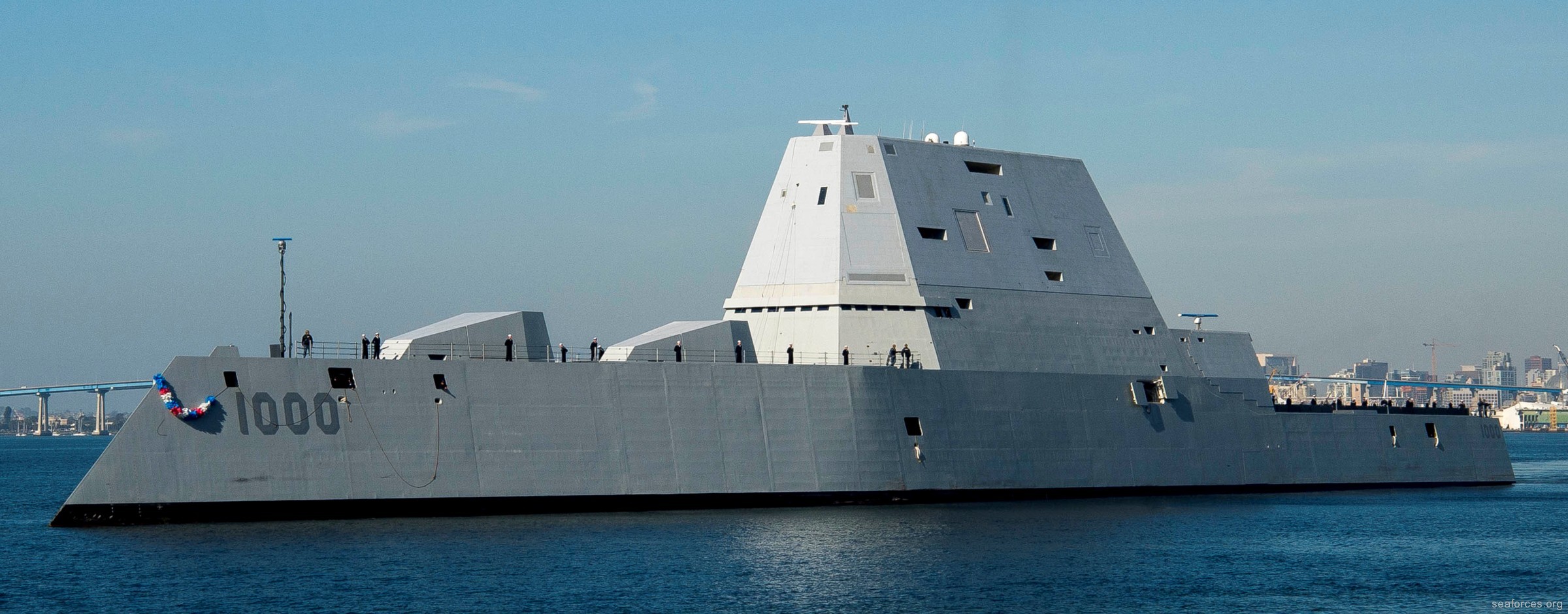 USS Zumwalt (DDG 1000) 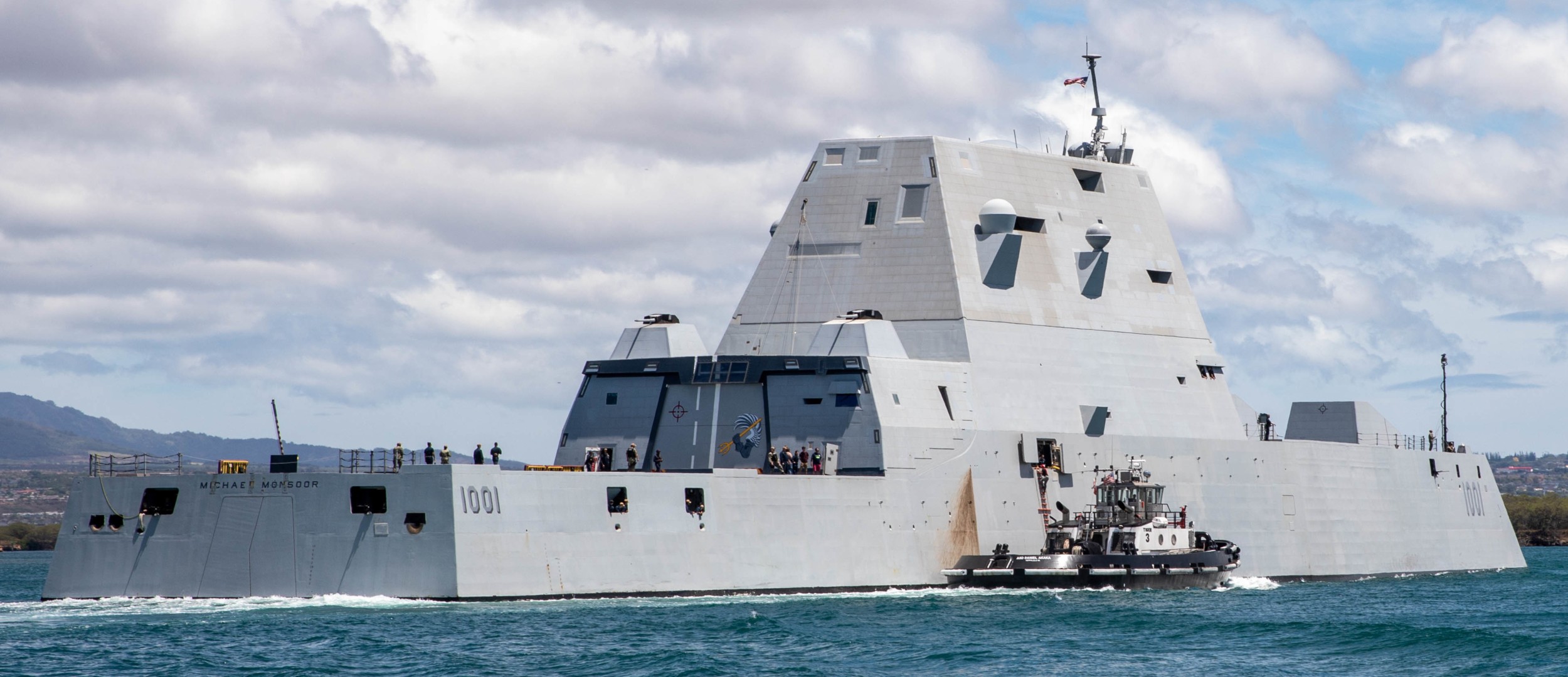 USS Michael Monsoor (DDG 1001) 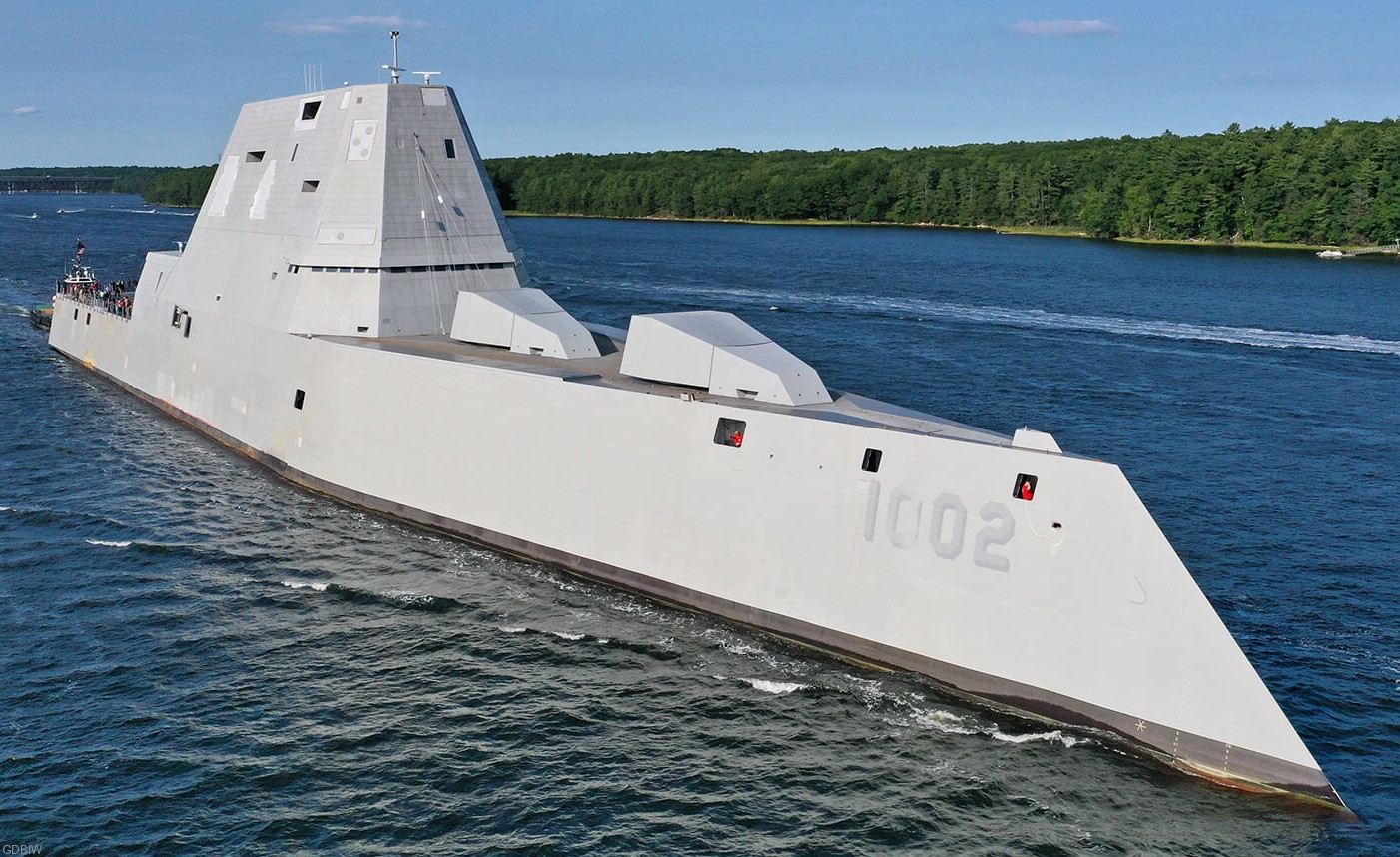 USS Lyndon B. Johnson (DDG 1002) 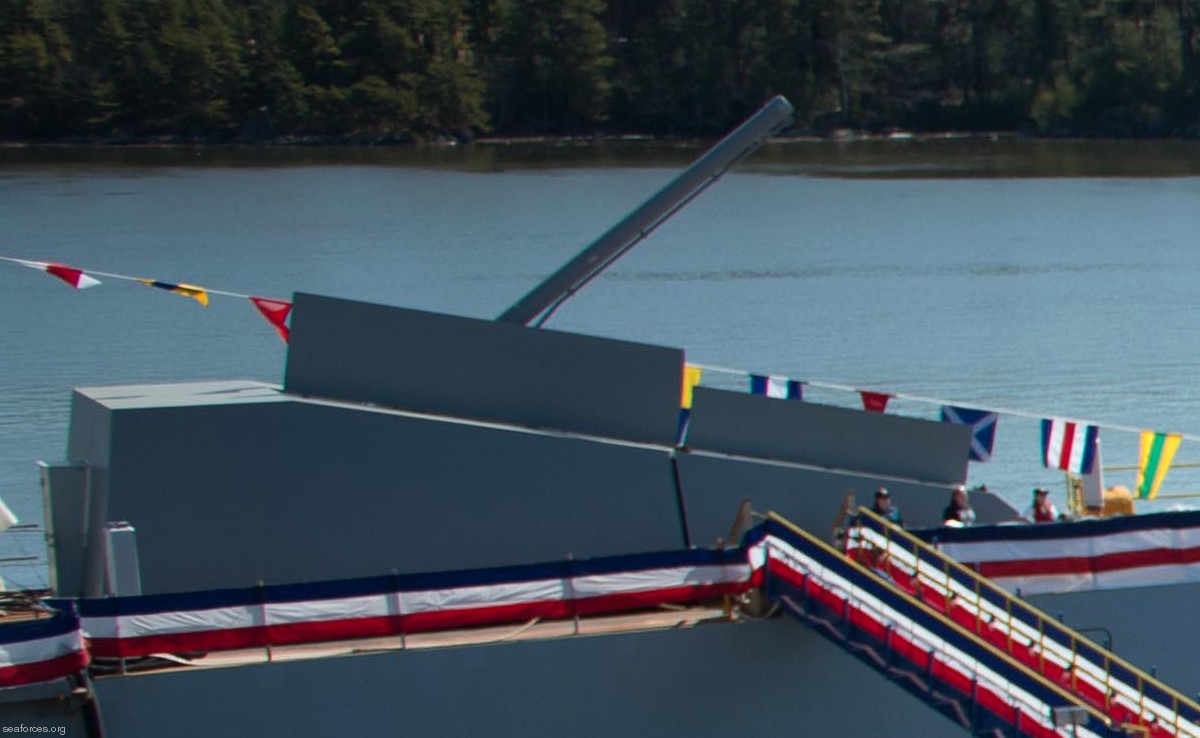 Advanced Gun System (155 mm - 6 inches/62-caliber) 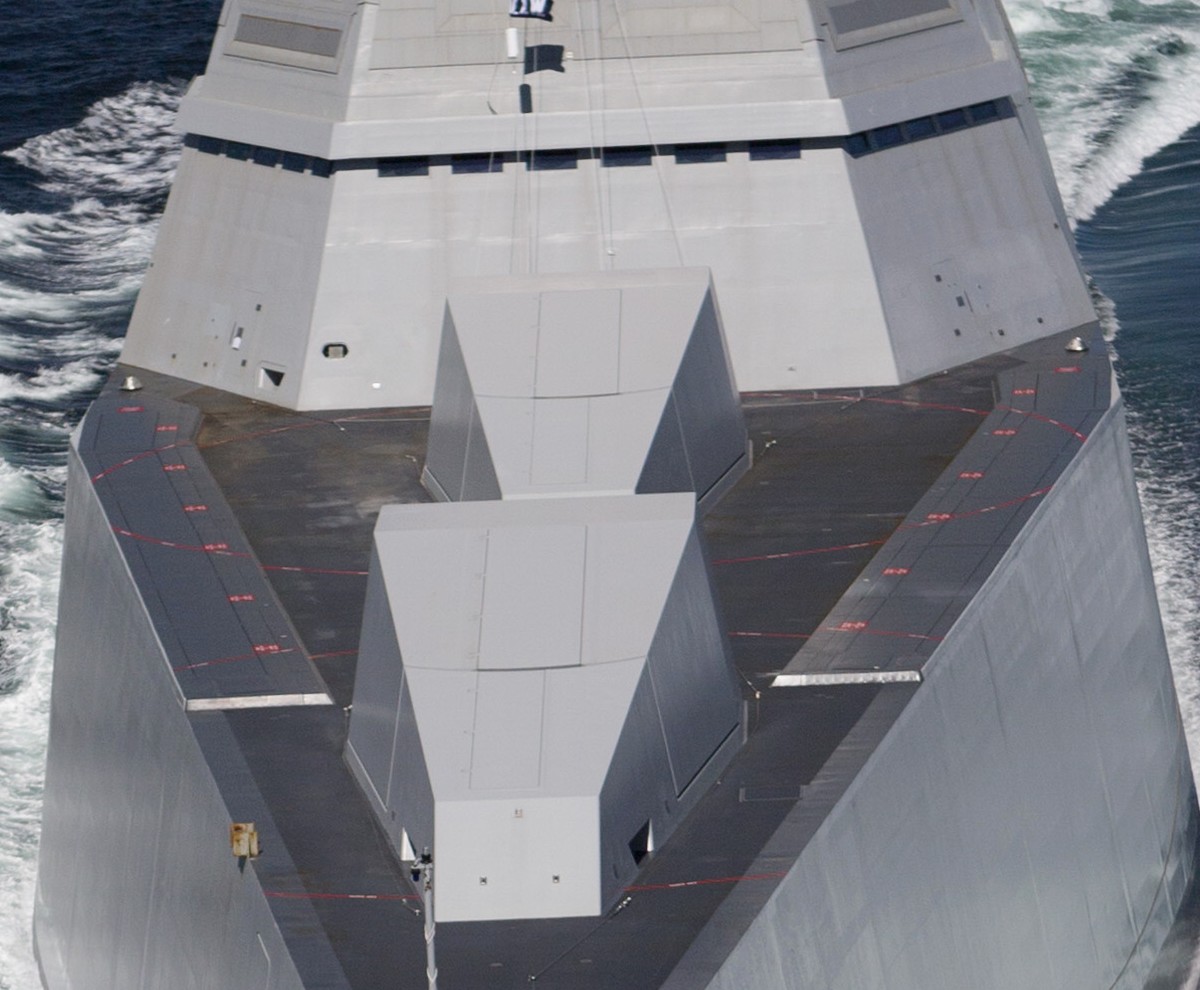 Advanced Gun System (155 mm - 6 inches/62-caliber) 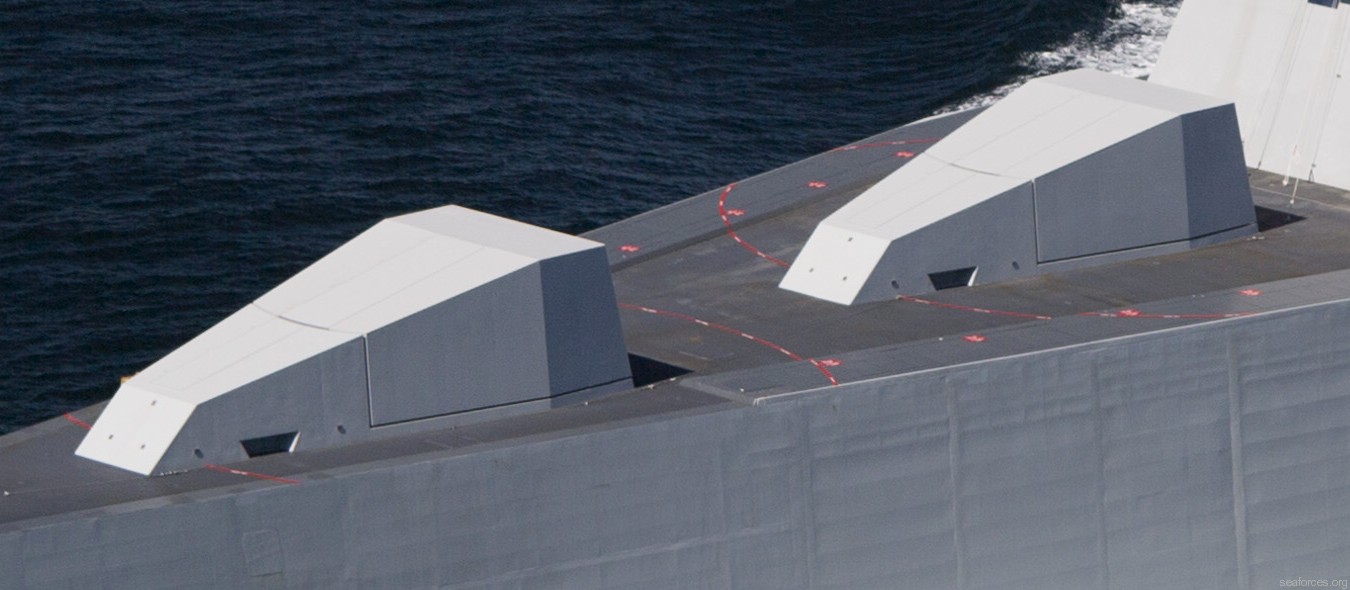 Advanced Gun System (155 mm - 6 inches/62-caliber) 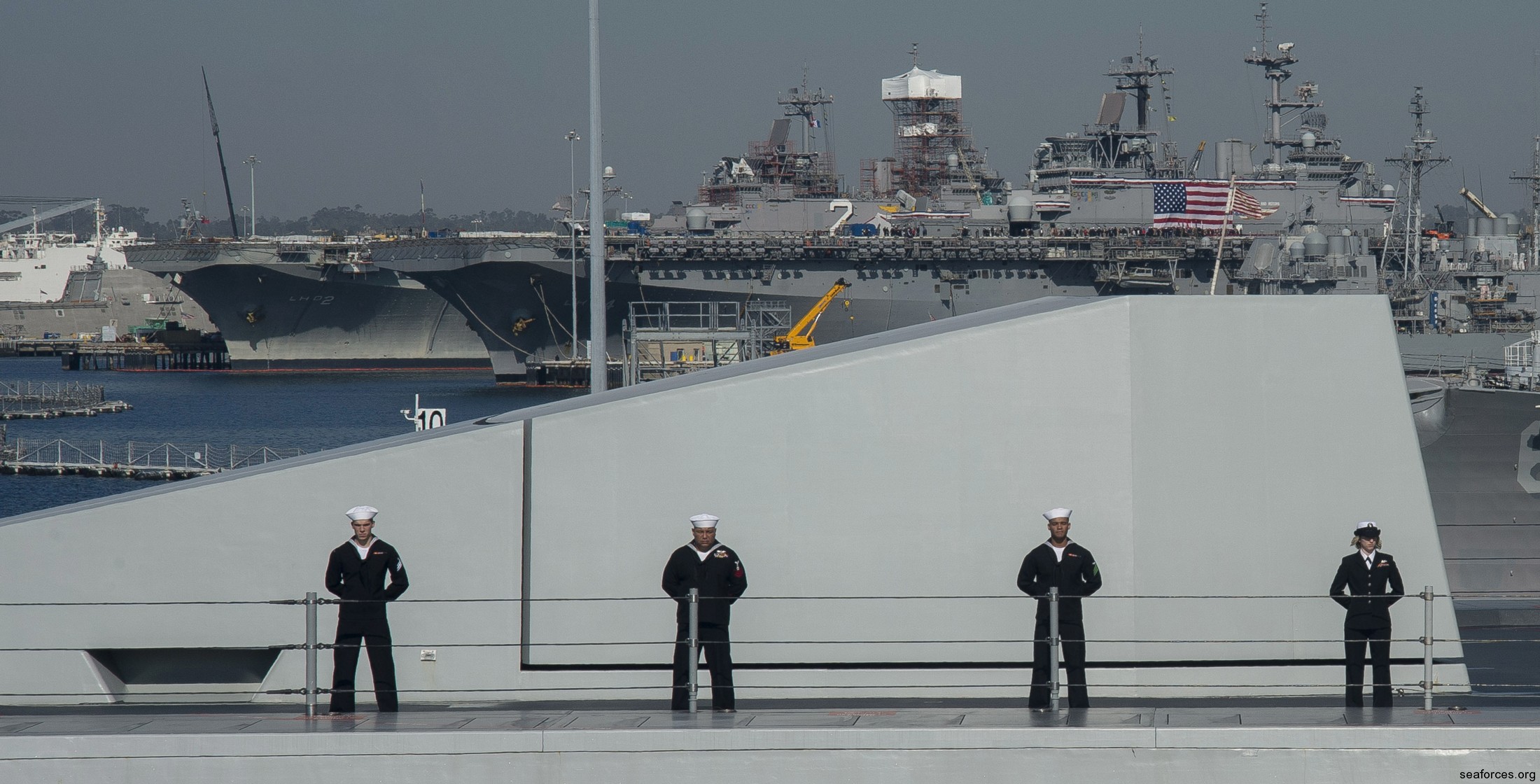 Advanced Gun System (155 mm - 6 inches/62-caliber) 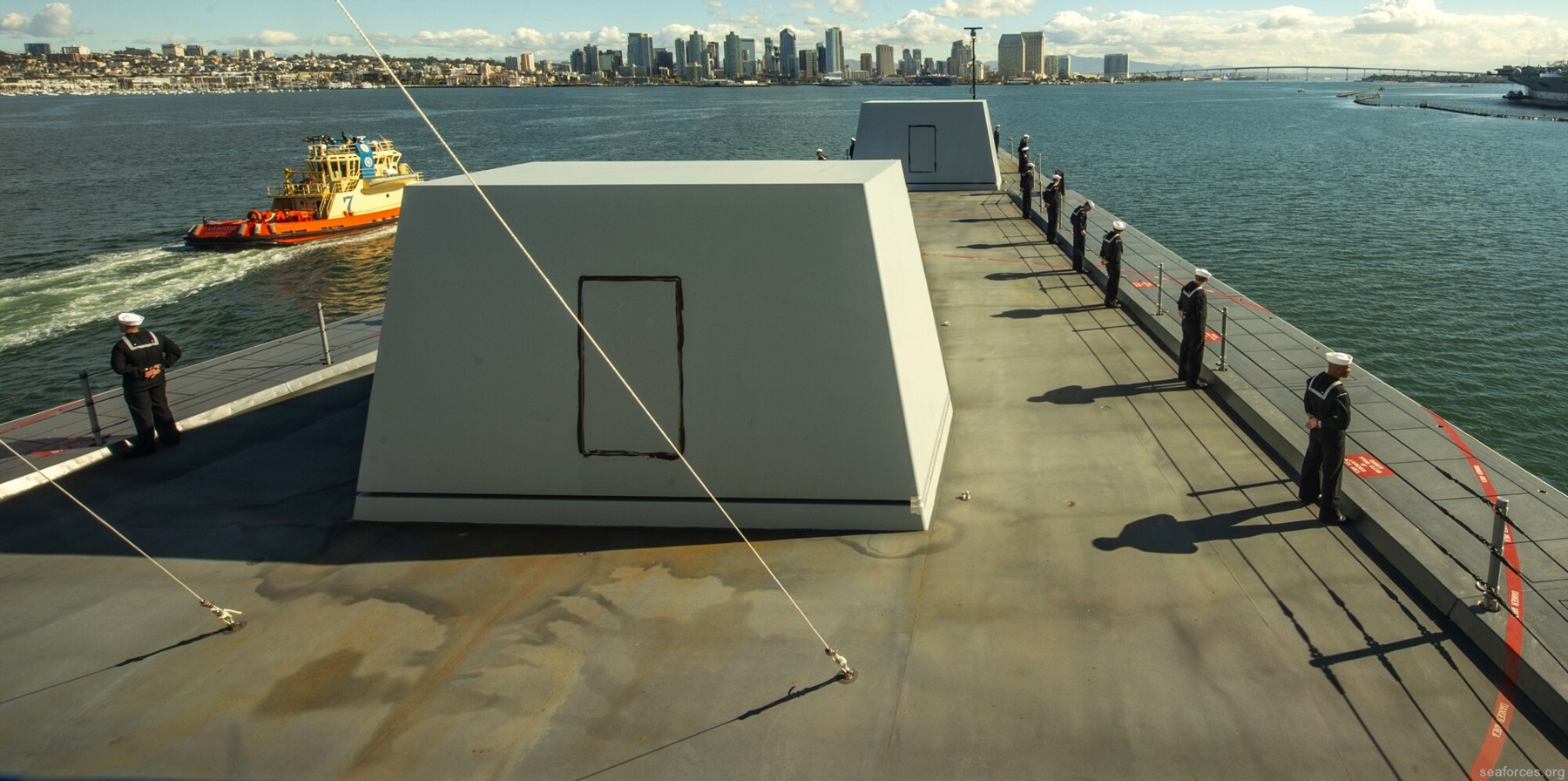 2 x Advanced Gun System and Mk-57 Veretical Launching System cells on both sides 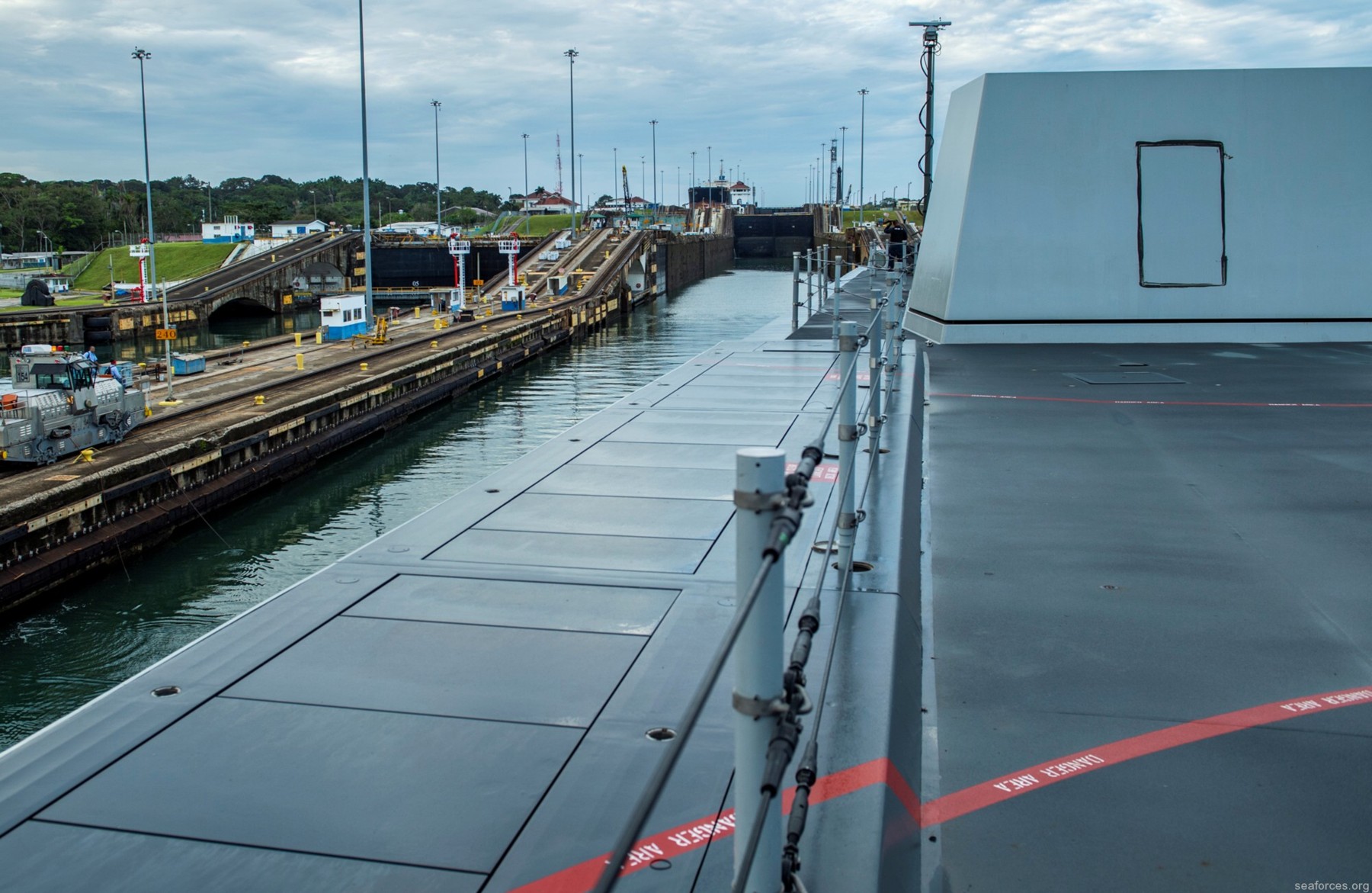 Mk-57 Peripheral Vertical Launching System (4-cell modules) 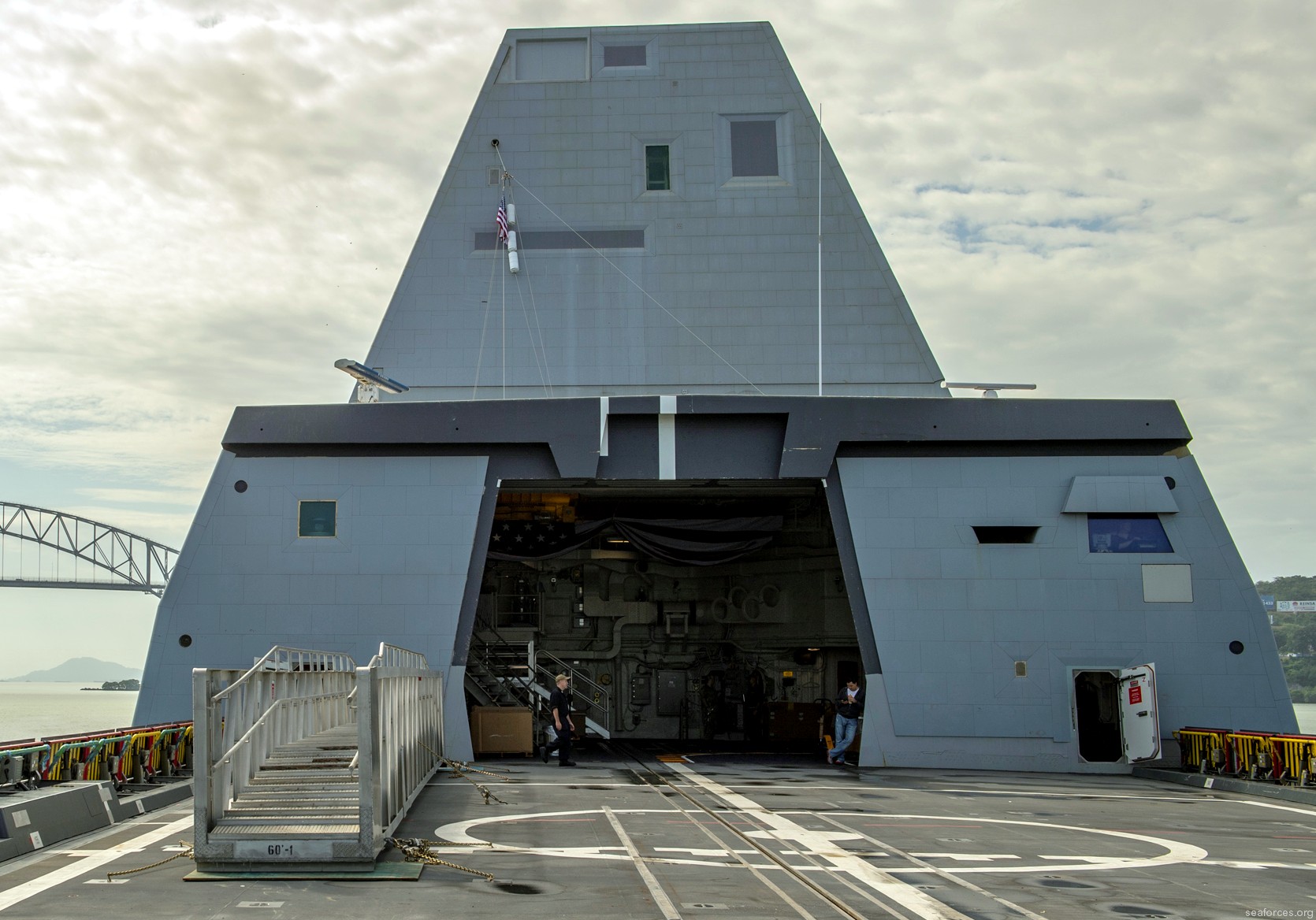 flight deck + hangar 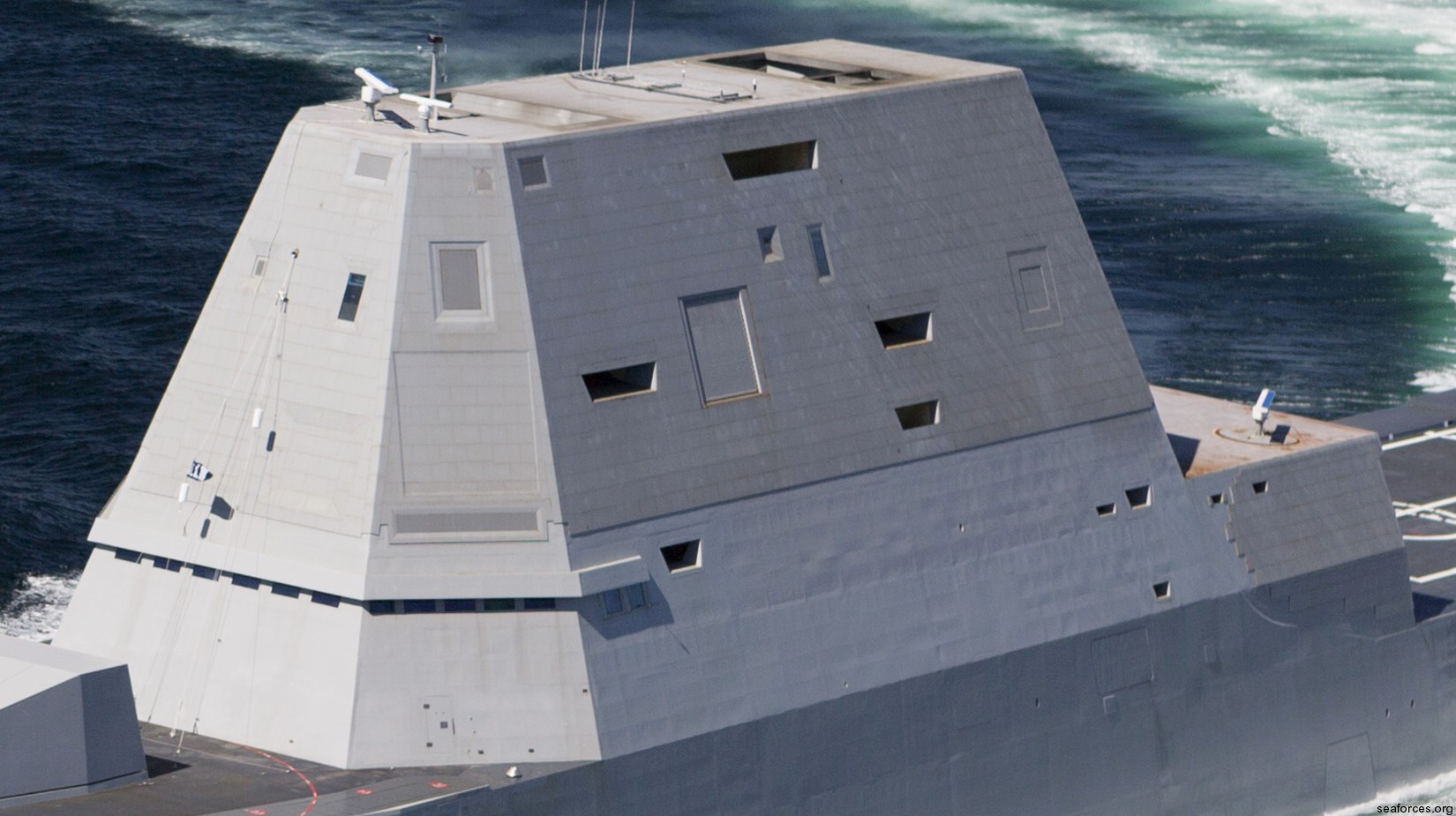 superstructure details 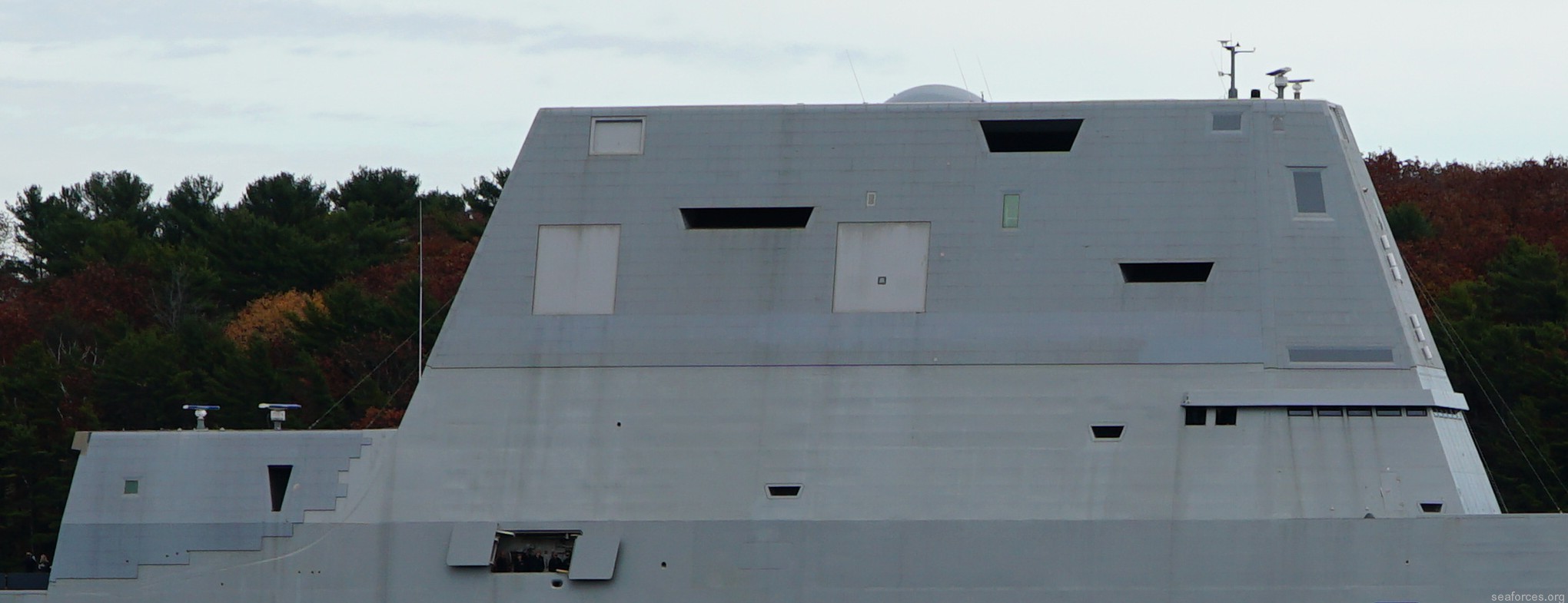 superstructure details 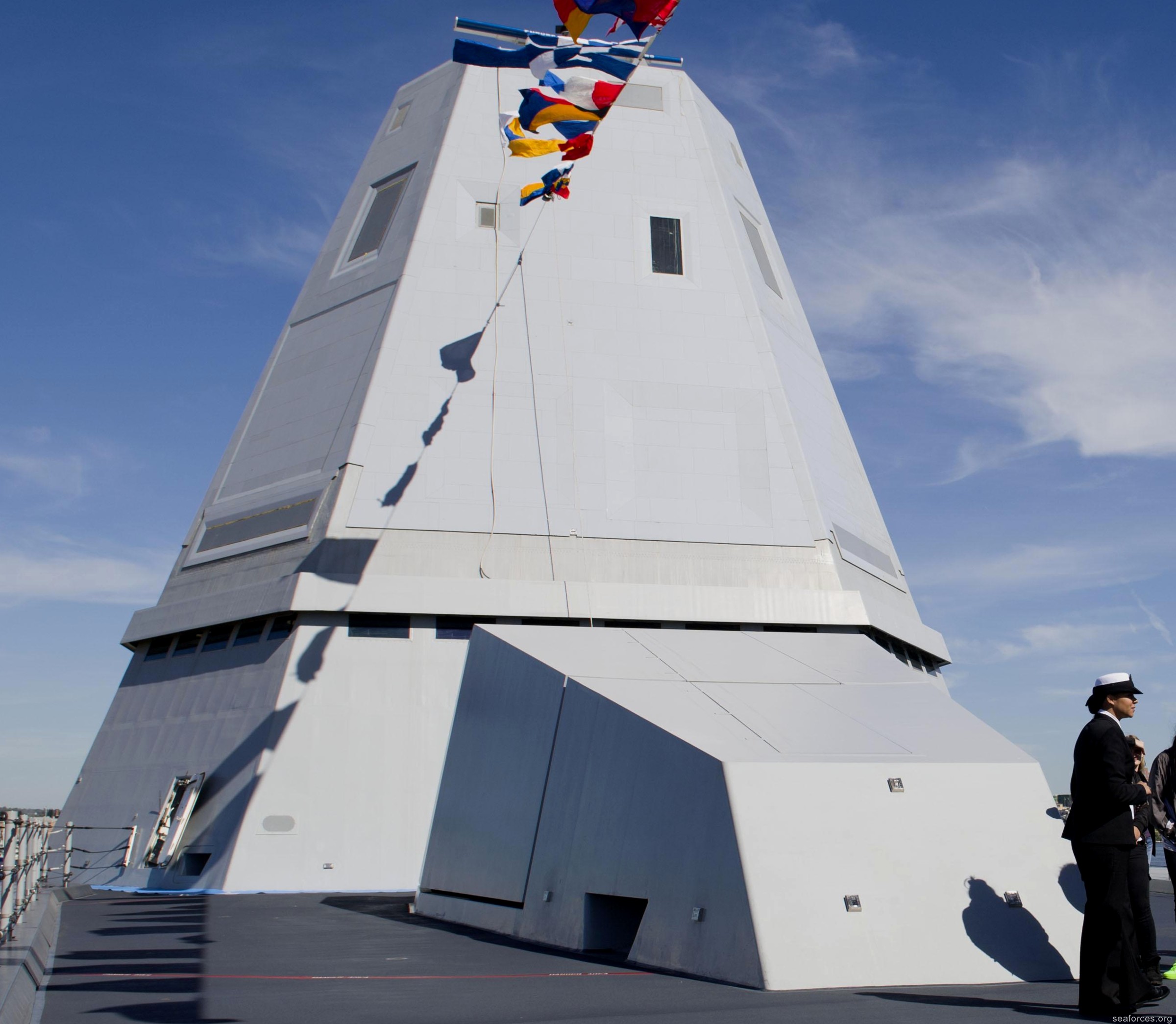 superstructure and gun details 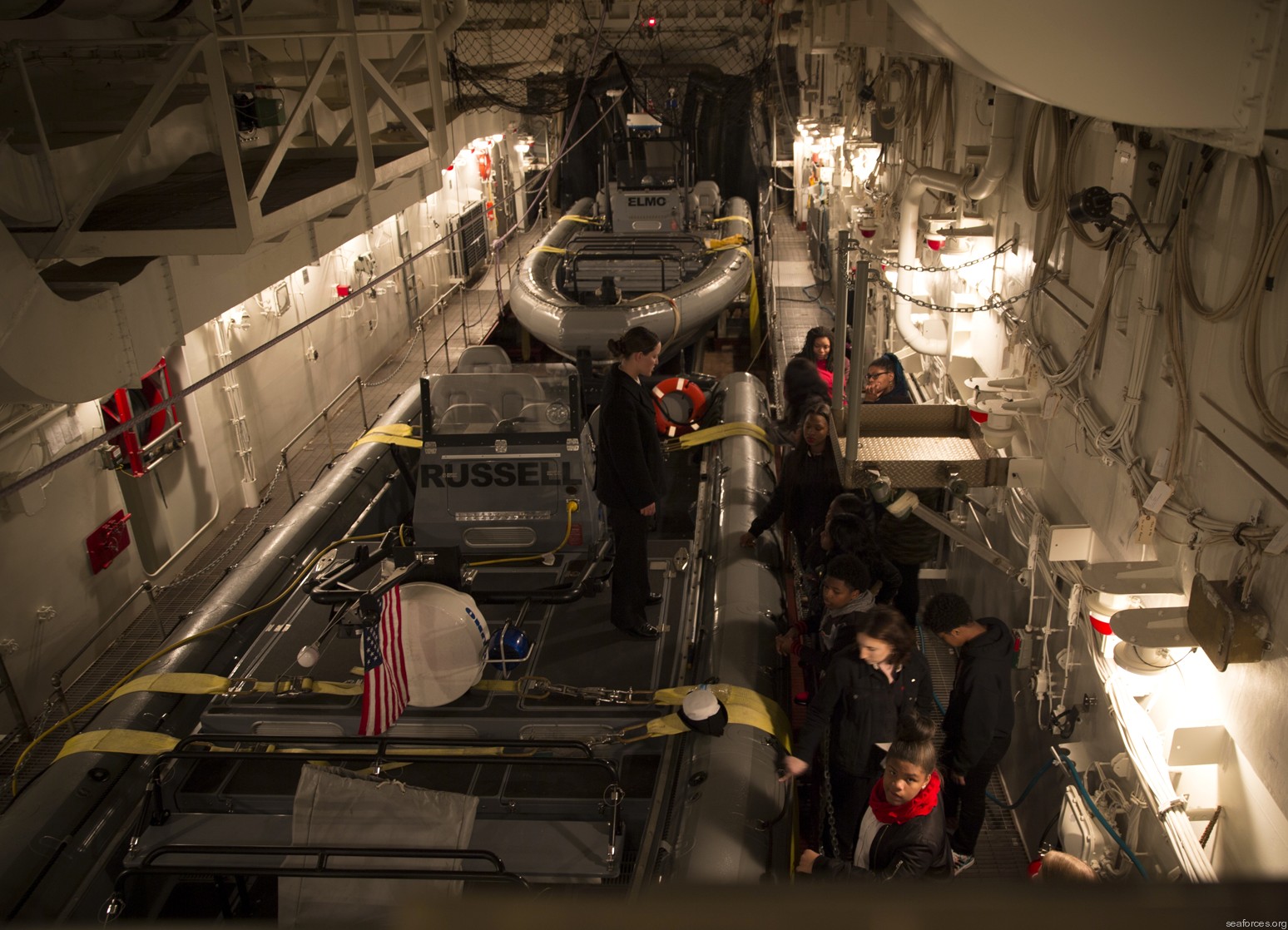 boat hangar and ramp in the stern 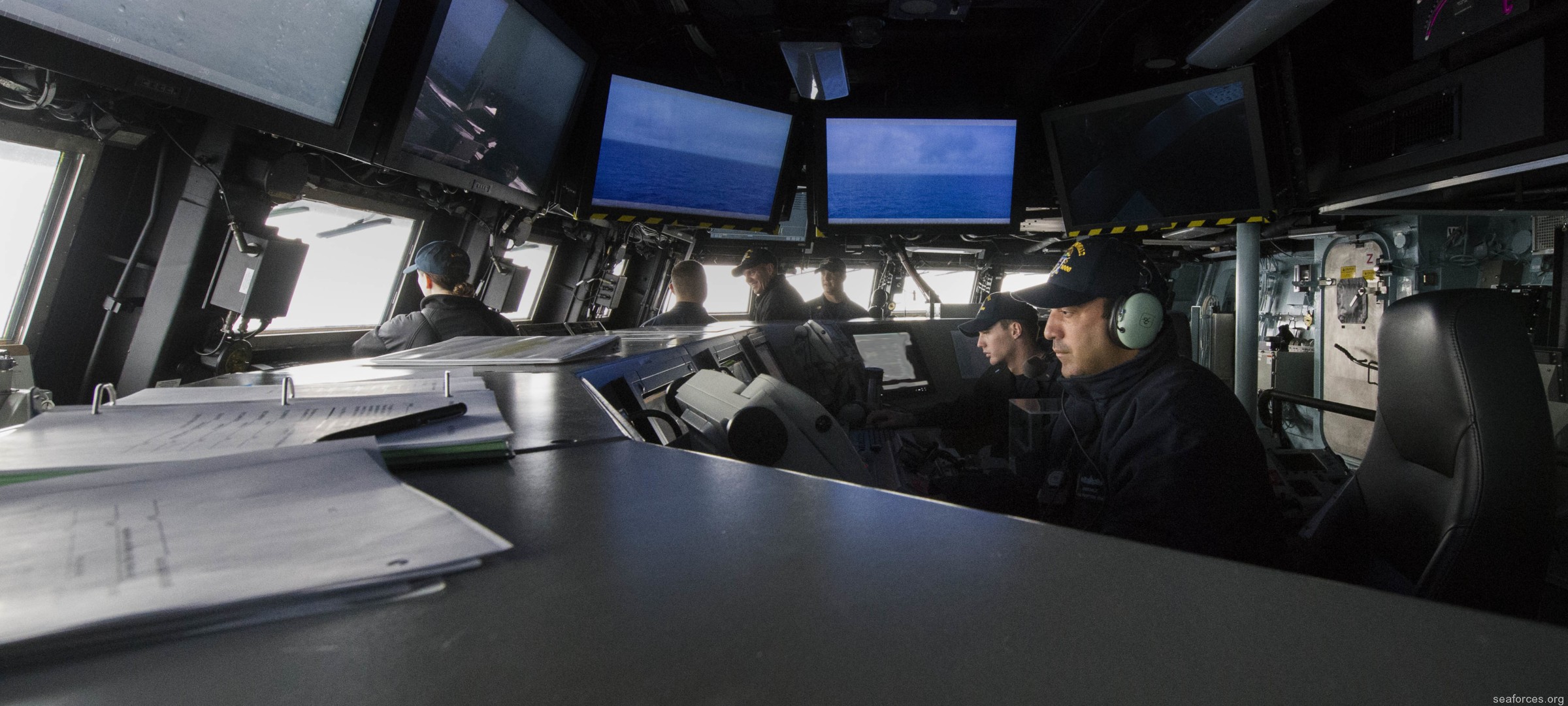 bridge 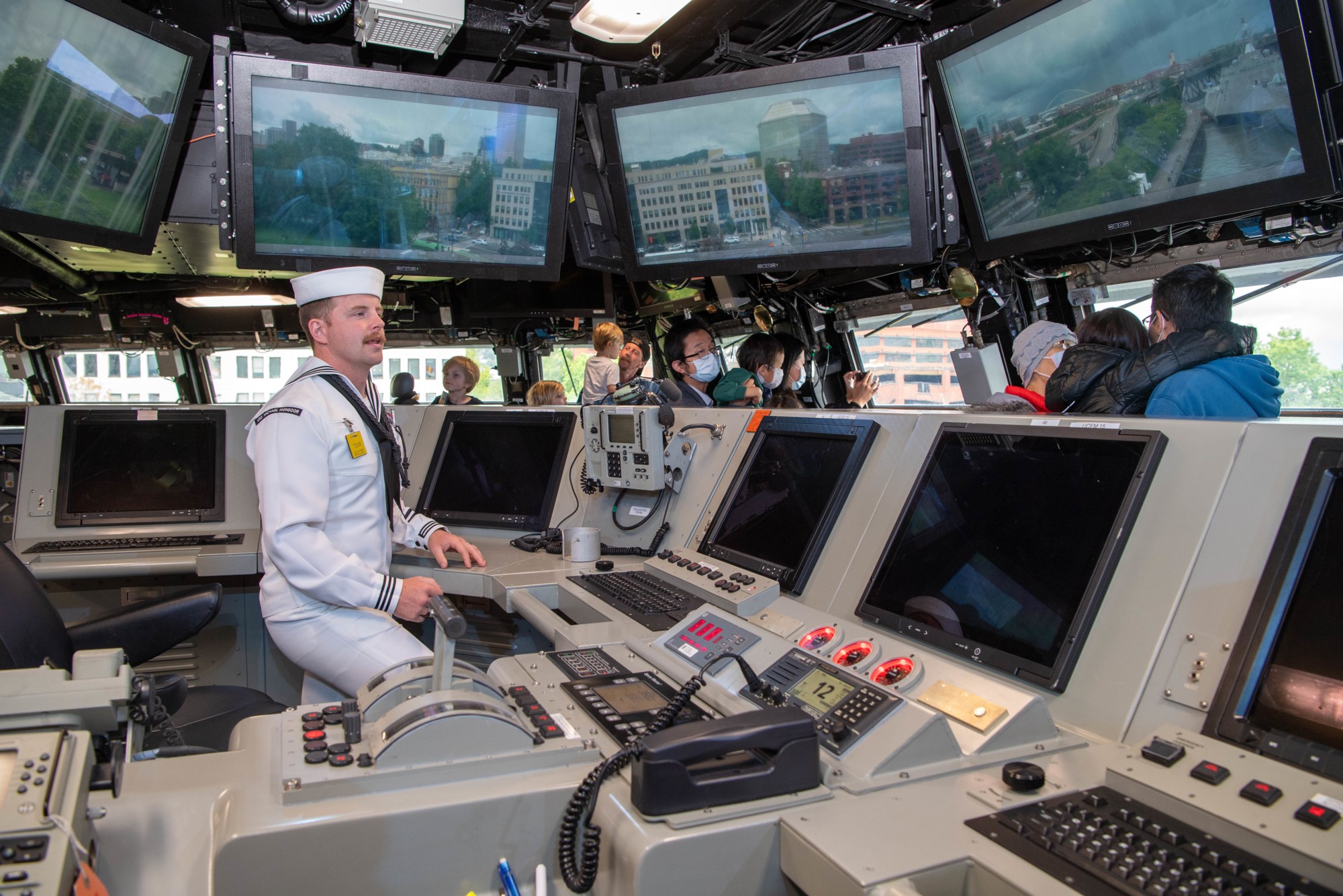 bridge |
|||
|
|
seaforces.org |
USN ships
start page | |
